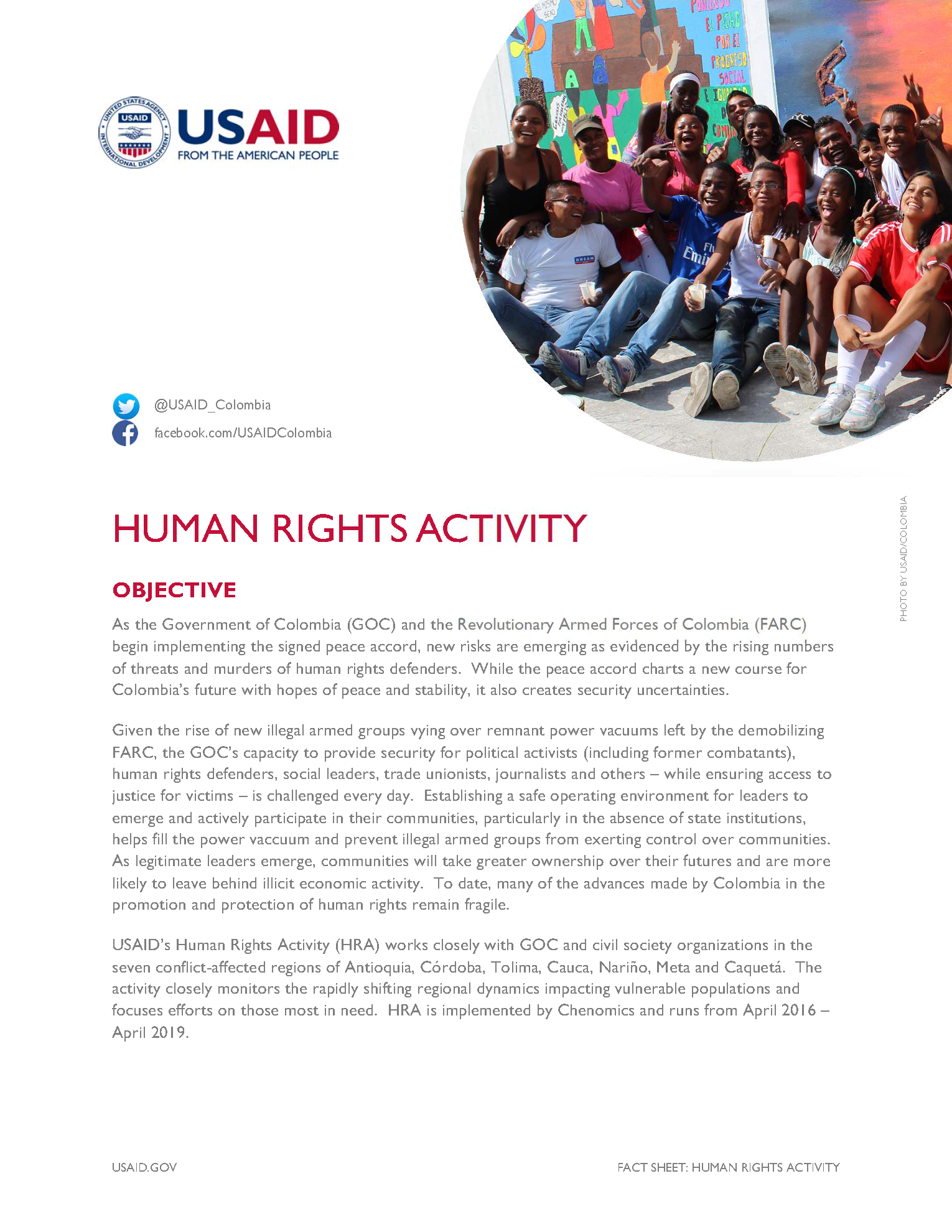Speeches Shim
DRG - Human Rights Activity (HRA) ![]() (pdf - 353k)
(pdf - 353k)
OVERVIEW
USAID’s Human Rights Activity (HRA) works with Government of Colombia (GOC) and civil society organizations to promote a culture of human rights and to prevent, and respond to, human rights violations. It does this by monitoring the rapidly shifting regional dynamics impacting vulnerable populations and focusing efforts on those most in need. HRA works in the conflict-affected regions of Antioquia, Córdoba, Tolima, Cauca, Nariño, Meta and Caquetá, and runs from April 2016 – April 2021.
HRA supports the implementation of 2016 peace accords between the GOC and the Revolutionary Armed Forces of Colombia (FARC). The signing of these accords created power vacuums in areas previously under FARC control and gave rise to new illegal armed groups. This posed new security threats to political activists, human rights defenders, social leaders, journalists and others. Establishing a safe environment for leaders to participate in their communities, particularly in the absence of state institutions, helps fill the power vaccuum and prevent illegal groups from exerting control over communities. As legitimate leaders emerge, communities will take greater ownership over their futures and are more likely to leave behind illicit economic activity.
COMPONENTS
Promoting a Culture of Human Rights
HRA strengthens GOC, civil society organizations, and Colombian citizens’ capacities to protect and promote a culture of human rights. The activity emphasizes human rights efforts in conflict-affected rural areas and supports national policies and programs. HRA concentrates on policy reform and peace accord implementation as they relate to the prevention and protection of human rights. Activities include a wide range of public awareness campaigns and training activities tailored for each beneficiary group, including public officials, the media, activists and students.
Preventing human rights violations
HRA helps the GOC and civil society prevent violations, and to respond effectively to violations when prevention fails. The activity supports the design and implementation of public policies to improve government and community capacities related to risk analysis and prevention measures. HRA also helps develop prevention and self-protection mechanisms for at-risk communities, including strengthening law enforcement’s capacity to interact with vulnerable populations in target regions.
Responding to human rights violations
HRA assists GOC institutions and civil society to address the needs of groups disproportionately affected by human rights violations. These groups—including victims of gender-based violence—have become increasingly vulnerable in the shifting context of the post accord reality.
RESULTS
- Trained 20,882 human rights defenders, including 1,395 in self-protection strategies;
- Supported 38 prevention working groups;
- Trained 844 public officials from 40 municipalities in prevention of human rights violations;
- Awarded 53 grants to civil society organizations to strengthen organizational capacity for the promotion, prevention, and response of human rights;
- Trained 1,949 public officials from seven departments in GBV prevention and response;
- Advanced 49 human rights defender cases through assistance to the Attorney General’s Office;
- Assisted the approval of three departmental human rights policies;
- Supported 30 gender working-groups; and
- Strengthened the Early Warning System to focus on the evolving human rights scenario, including emitting three national-level warnings and four local warnings in Cauca, the department with the highest number of human rights defender homicides.


Comment
Make a general inquiry or suggest an improvement.